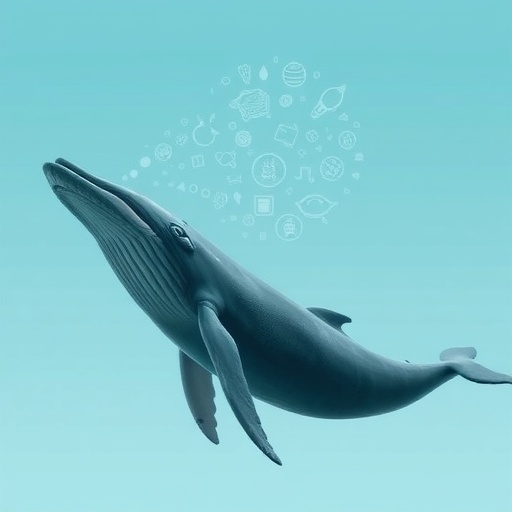In a groundbreaking study published in The ISME Journal, scientists have for the first time elucidated a direct link between the respiratory microbiomes of free-ranging North Atlantic right whales and their overall health status. This discovery marks a significant advancement in marine biology, offering a non-invasive means to monitor some of the ocean’s most endangered mammals. The critically endangered North Atlantic right whale population, which has dwindled to fewer than 400 individuals due to varied anthropogenic and environmental pressures, can now be assessed with innovative diagnostic techniques that minimize human impact.
The research was conducted over an eight-year period spanning from 2016 to 2024, during which a consortium of scientists from prestigious institutions, including Woods Hole Oceanographic Institution (WHOI), University of St Andrews, and New England Aquarium, employed drone technology to collect 103 respiratory samples from 85 North Atlantic right whales. This utilization of unmanned aerial systems allowed researchers to safely approach whales in situ, capturing exhaled breath condensate from their blowholes. The drones carried sterile collection plates positioned just above the animal’s blow as it surfaced and exhaled, gathering microbial material critical to this microbiological and ecological investigation.
Drones proved especially advantageous by providing a stable, quiet platform that reduced the stress and disturbance typically caused by direct human interaction or vessel presence. The deployment of drones in this manner bypassed the challenges and risks of boat-based sampling, particularly relevant for an endangered species highly vulnerable to additional stressors. Besides collection ease, this approach allowed researchers access to individuals in difficult-to-reach or otherwise dangerous marine environments, ensuring a more comprehensive respiratory microbiome dataset.
At a molecular level, the study revealed that the breath microbiomes of these whales exhibit distinctive patterns that correlate with individual health conditions. Diverse microbial communities isolated from the samples indicated differences between whales classified as robust versus those deemed thin or otherwise compromised. This finding suggests that microbial signatures in whale exhalations can serve as biomarkers for physiological status, much like how human breath analysis provides clues about respiratory and systemic health.
The data from breath samples were rigorously paired with multi-modal health indices, including photogrammetric body condition assessments derived from aerial imaging, visual health examinations conducted during field observations, and integrated health models based on longitudinal survival data. This interdisciplinary synthesis allowed researchers to cross-reference microbiological findings with empirical phenotypic and ecological measurements, furnishing a robust framework for validating microbial indicators of health.
Carolyn Miller, a large whale biologist at WHOI and lead author of the study, emphasized that this work represents a pivotal leap towards wildlife health monitoring. The ability to develop non-invasive diagnostic tools based on respiratory microbial communities has the potential to revolutionize how conservationists track the well-being of marine megafauna. By harnessing microbes as sentinels, researchers can gain real-time insights into the physiological states of whales without the risks inherent in invasive sampling.
Complementing this, Enrico Pirotta, a co-lead author and statistical ecologist at the University of St Andrews, highlighted the significance of measuring individual whale health as a fundamental component for understanding the impacts of multiple concurrent stressors. Ship strikes, fishing gear entanglements, and changing oceanographic conditions impose complex challenges on whale populations. Quantitative health indicators gleaned from microbiome profiles will be instrumental in developing targeted conservation strategies and adaptive management policies designed to mitigate these threats.
Amy Apprill, associate scientist at WHOI and co-author, remarked on the novel window into whale biology opened by integrating drone technology with cutting-edge microbiome science. This approach enables a ‘health checkup’ from a distance, devoid of physical contact. The convergence of microbial ecology and aerial remote sensing presents a transformative toolkit for marine mammal health surveillance, potentially extendable to various species beyond the North Atlantic right whale.
The study’s reliance on extensive long-term datasets, such as photo-identification catalogs and health monitoring logs, was crucial for establishing baseline microbial and health profiles. This historical context enriched the interpretation of respiratory microbiomes, allowing researchers to detect shifts potentially attributable to environmental changes or health deterioration. It underscores how sustained ecological data collection forms the backbone of innovative wildlife health research.
Further, the research was supported by robust funding from Strategic Environmental Research and Development Program, Office of Naval Research, NOAA, and SR³, highlighting the importance placed on multidisciplinary and technologically advanced conservation science. The collaborative engagement between governmental agencies, academic entities, and conservation organizations exemplifies a model for addressing urgent ecological issues through science-driven, policy-relevant research.
Looking ahead, this study sets the stage for deploying drone-enabled respiratory microbiome monitoring as a routine conservation tool. Such approaches bear promise not only for tracking individual whale health trajectories but also for early detection of emerging diseases or stress-related pathologies within populations. The non-invasive nature ensures ethical compliance and minimal interference with natural behaviors, a critical aspect for vulnerable marine species.
In summary, the integration of drone technology, microbial ecology, and long-term ecological datasets has unlocked a novel frontier in marine mammal health monitoring. The North Atlantic right whale, emblematic of oceanic conservation challenges, now has a new ally in the form of respiratory microbiomes, harnessed through innovative remote sampling techniques. This pioneering work exemplifies how modern technological advances can be skillfully utilized to deepen our understanding and protection of ocean megafauna.
Subject of Research: Animals
Article Title: Respiratory microbiomes reflect whale health
News Publication Date: 12-Nov-2025
Web References: https://doi.org/10.1093/ismejo/wraf231
Image Credits: NEAq/WHOI, NMFS/NOAA Permit #21371
Keywords: Imaging, Population studies, Observational studies




